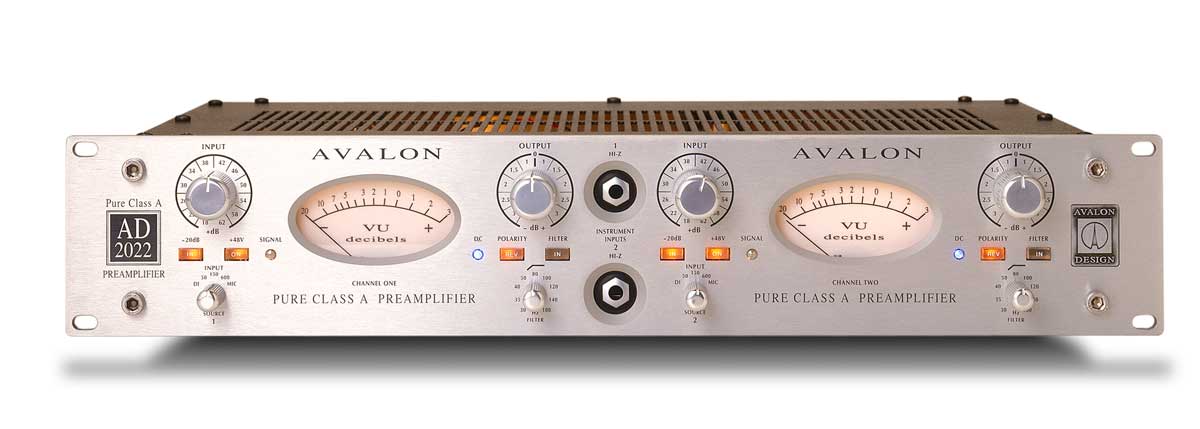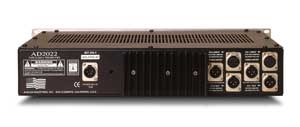
|
REVIEWS: | |||||
|
Steve La Cerra for EQ Magazine
AVALON DESIGN AD2022
Dual Mono Class A Preamplifier
Does adjustable input impedance make for a great mic
pre?
The newest member of Avalon Design's AD2000 Series, the AD2022 is a two-channel, fully discrete solid-state microphone preamplifier. The AD2022 shares lineage with Avalon's M5 mic pre, though the AD2022 employs a fully balanced signal path and its maximum output level is higher than that of the M5. Perhaps most intriguing, each channel of the AD2022 features a five-position rotary switch for adjusting the input impedance. A balanced input transformer allows the load to be matched to the particular microphone in use. Though this concept has been largely overlooked in modern mic preamp design, it's interesting to note that manufacturers such as RCA produced mic preamps specifically matched to load their microphones correctly. As of this writing there's only one other preamp I know of providing this feature (GT Electronics' VIPRE). The Tour Front-panel controls for each channel include stepped input gain and continuous output level knobs as well as 20 dB pad, phantom power, polarity reverse, and high-pass filter in/out switches. Two smaller knobs provide adjustment of the input impedance and high-pass filter turnover frequency. In addition to a large VU meter, each channel has a bi-color LED indicating signal present (green) and overload (red). A 1/4-inch TS jack allows direct injection of an instrument-level source. Blue LED's for each channel indicate proper DC supply from the external power supply (included).
With a quarter-inch-thick front panel and high-quality parts under the hood, it's obvious that the AD2022 is a serious piece of audio gear. Attention to detail is meticulous, as shown in the neat PCB layout, WIMA caps, sealed-silver relays on all push-button switches, and hex-head screws. Gain, output level, and filter pots all have an extremely smooth, solid feel, though the impedance select switches had a bit of play to them. Plugged In I used the AD2022 with a variety of microphones including a Neumann U 87, KM84, and TLM103; beyerdynamic M88, RCA 44BX, Sennheiser MKH404, Audix D1, D2, and D4; CAD Equitek E-350, and Shure SM57. All of these mics benefited from use of the AD2022. I was hoping that the AD2022 might share the M5's low-frequency extension and I was not disappointed. Kick drum through the Audix D4 was massive, with a bottom octave most pre's just don't dig deep enough to capture.
Operationally speaking there are a lot of pluses on the AD2022: The switches operate silently without creating any noises - even the phantom power switch. Turning phantom power off while monitoring the output (not something I'd make a habit of) doesn't produce the horrendous pop you'd expect; turning phantom power back on results in a muted thump at a level low enough not to damage a monitor speaker if the volume happens to be up. A stepped resistor is used for input gain control, meaning you'll be able to accurately repeat session settings. This, along with the continuous output control - which covers a range of plus or minus three dB - easily enables fine tuning of levels in between the four dB steps of the input gain knob. I was pleasantly surprised to find that the AD2022's DI was more than a gratuitous hole in the front panel. I used it for analog synth bass sounds, and the results were excellent. Low-frequency extension was ridiculous (in a good way), and having all that headroom allowed me to print hot levels without worry of running out of gas. Even on electric guitar the DI was more than just "usable" - a bit of compression and chorus, with the low-cut filter wound up near 80 or 100 Hz gave me a good clean rhythm guitar tone (unlike most pre's where the DI...well...sucks). Input Impedance The big question is whether or not the AD2022's adjustable input impedance makes any real difference. The answer: yes, almost always. With some mics the difference was subtle, and with others, drastic. All of the mics reacted to impedance switching in terms of their output level. Each mic had a setting where a minimum of gain on the AD2022 was needed to drive the next signal stage to a particular level. Taking the time to find this setting paid off clearly in reducing the amount of noise introduced to the chain (though the AD2022 introduces very little noise in the first place). The most dramatic example was with a pair of 35-year-old Sennheiser MKH404 RF condenser mics. These mics use a small outboard power supply, plus a set of cables on the output of the supply that include balancing transformers. The MKH404's are picky about the mic pre to which they're connected. When I found the "correct" impedance, the output of the MKH404's jumped roughly six to eight dB higher for an identical input gain setting. This difference made for a major improvement in the noise floor. It also sounded to me as if at the highest impedance setting ("Mic") the distortion level increased, perhaps due to transformer saturation. On the U87, the 150-ohm setting seemed to reduce background noise most effectively, and I also felt it was slightly cleaner. I opted for this setting, which sounded more natural, as opposed to some of the others that resulted in hotter output but a less natural sound. My RCA 44BX sounded most open in the top end at the 600-ohm setting, but the "Mic" setting was most quiet. Differences with the SM57 were subtle; it was a touch thinner at 50 or 150 ohms, yet more quiet at 600 or "Mic." (I do have to mention that using a '57 through the AD2022 for a snare drum really sounded good at any setting.) When using the Neumann TLM103 or the CAD E-350, different impedance settings made a minimal change in the sound. Avalon will be including a chart with the AD2022 that lists suggested settings for popular microphones. Dialed In Avalon has gracefully risen to the challenge of adding a new unit to their well-established AD2000 Series. The AD2022 is quiet, transparent, easy to operate, and feels well built. The low-frequency extension practically makes it a must for kick drum, and bass synth or bass guitar recording. The ability to "tune" the input transformer to the mic you're using makes the AD2022 very versatile, and can be very effective with certain mics. You might even find that you rediscover your microphone collection! Summary: Two-channel, discrete Class-A microphone preamplifier with DI Strengths: Variable mic input impedance. Quiet. Transparent signal path. Excellent headroom. Easy operation. Weaknesses: Remote power supply. Manual needs to furnish more information regarding variable impedance settings. Price: $3,000 Specifications Maximum input gain 64 dB Noise level -102 dB, unweighted at 20 kHz Frequency range 1 Hz to 120 kHz Input impedance 50, 150, 600, or 1.5k ohms Distortion 0.05% nominal
Back to Reviews Index & User List |
Tel: +1 949 492 2000
©2023 Avalon Design USA LLC


